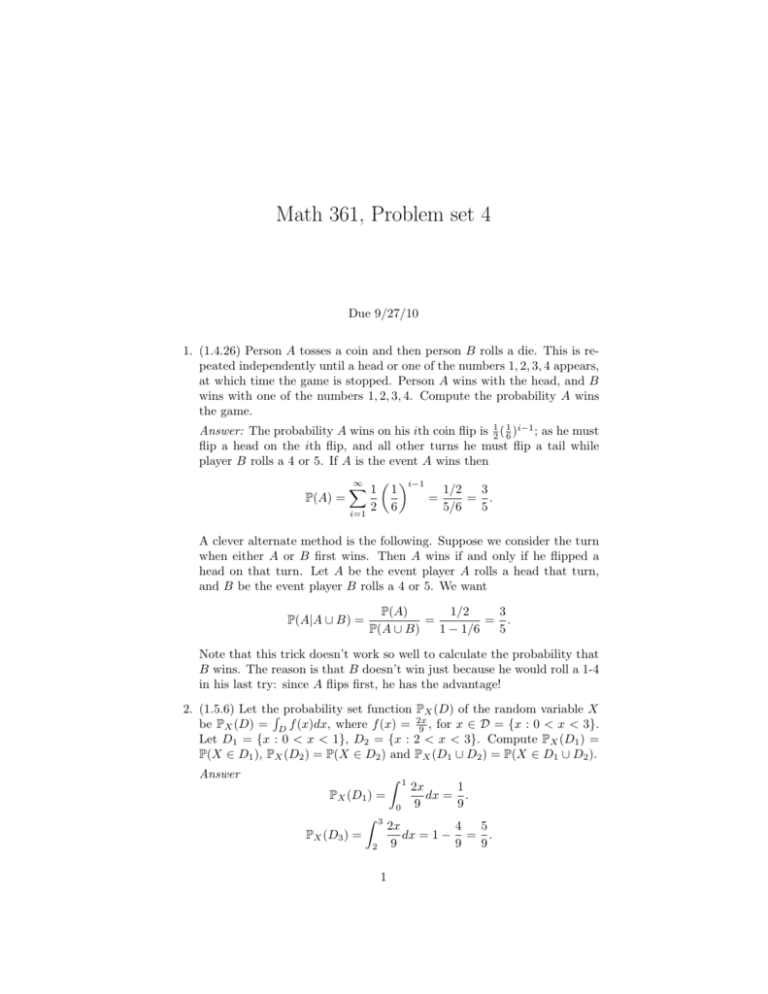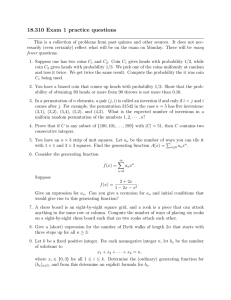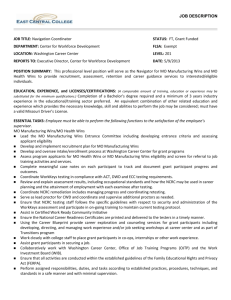Math 361, Problem set 4
advertisement

Math 361, Problem set 4
Due 9/27/10
1. (1.4.26) Person A tosses a coin and then person B rolls a die. This is repeated independently until a head or one of the numbers 1, 2, 3, 4 appears,
at which time the game is stopped. Person A wins with the head, and B
wins with one of the numbers 1, 2, 3, 4. Compute the probability A wins
the game.
Answer: The probability A wins on his ith coin flip is 12 ( 61 )i−1 ; as he must
flip a head on the ith flip, and all other turns he must flip a tail while
player B rolls a 4 or 5. If A is the event A wins then
P(A) =
i−1
∞
X
1 1
i=1
2
6
=
1/2
3
= .
5/6
5
A clever alternate method is the following. Suppose we consider the turn
when either A or B first wins. Then A wins if and only if he flipped a
head on that turn. Let A be the event player A rolls a head that turn,
and B be the event player B rolls a 4 or 5. We want
P(A|A ∪ B) =
P(A)
1/2
3
=
= .
P(A ∪ B)
1 − 1/6
5
Note that this trick doesn’t work so well to calculate the probability that
B wins. The reason is that B doesn’t win just because he would roll a 1-4
in his last try: since A flips first, he has the advantage!
2. (1.5.6) Let the
R probability set function PX (D) of the random variable X
be PX (D) = D f (x)dx, where f (x) = 2x
9 , for x ∈ D = {x : 0 < x < 3}.
Let D1 = {x : 0 < x < 1}, D2 = {x : 2 < x < 3}. Compute PX (D1 ) =
P(X ∈ D1 ), PX (D2 ) = P(X ∈ D2 ) and PX (D1 ∪ D2 ) = P(X ∈ D1 ∪ D2 ).
Answer
Z
PX (D1 ) =
0
Z
3
PX (D3 ) =
2
1
1
2x
1
dx = .
9
9
2x
4
5
dx = 1 − = .
9
9
9
1 5
6
+ = .
9 9
9
In the last, we used that D1 ∩ D2 = ∅ .
PX (D1 ∪ D2 ) =
3. (1.5.5) Let us select five cards at random and without replacement from
an ordinary deck of playing cards.
(a) Find the pmf of X, the number of hearts in the hand.,
(b) Determine P(X ≤ 1).
Answer For x = 0, 1, 2, 3, 4, 5
13
x
39
5−x
52
5
P(x) =
.
with p(x) = 0 otherwise.
For (b), we have
39
5
P(X ≤ 1) =
+ 13
52
39
4
.
5
1
4. A weighted coin, with head probability 10
is flipped n times, where n is
divisible by 10. Let X denote the number of heads flipped. Then the
pmf of X is p(k) = nk (1/10)k (9/10)n−k . Show which value of k this
maximizes this. Hint: Look at the ratio: p(k)/p(k + 1). When k is small,
this is less than one, when k is large, this is bigger than one. Find the
value of k when p(k)/p(k + 1) ≈ 1. Why does this work?
Answer:
p(k)
=
p(k + 1)
n
k
n−k
k+1
k (1/10) (9/10)
9̇.
=
n
k+1 (9/10)n−k−1
n
−k
(1/10)
k+1
p(k)
We have that p(k+1)
= 1 when 9(k + 1) = (n − k), k ≈ n−9
10 . This works,
because as p(k) is increasing then decreasing (the fancy term for this is
unimodular) then by finding where p(k)/p(k + 1) is as close to one as
possible, we find the maximum.
5. (1.6.3) Cast a die a number of independent times until a six appears on
the up side of the die.
(a) Find the pmf p(x) of X, the number of casts needed to obtain that
first six.
P∞
(b) Show that x=1 p(x) = 1.
(c) Determine P(X = 1, 3, 5, 7, . . . ).
(d) Find the cdf FX (x) = P(X ≤ x).
2
Answer:
For (a)
p(x) =
1
6
x−1
5
6
for x = 1, 2, 3, . . . with p(x) = 0 otherwise.
For (b):
x−1
∞
X
1 5
x=1
6
6
=
1/6
= 1.
1 − 5/6
For (c):
P(X = 1, 3, 5, 7, . . . ) =
2x
∞
X
1 5
6
x=0
6
=
1/6
.
1 − (5/6)2
For (d):
FX (x) = P(X ≤ x) = P(X ≤ [x]) =
k−1
[x]
X
1 5
k=1
with FX (x) = 0 for x < 1.
3
6
6
=1−
[x]
5
.
6











